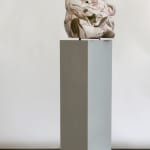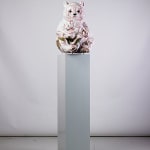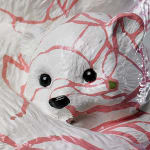

Gary Hume, Untitled, 2009

Gary Hume, Untitled, detail, 2009
Gary Hume RA
Further images
Gary Hume was born in 1962, in Kent. He started work as an assistant film editor before concentrating on studying art. He graduated from Goldsmiths College in 1988 and took part in the seminal Freeze exhibition curated by Damien Hirst, thus becoming part of the generation of young British artists that emerged in the 1990s. His work was included the infamous YBA sensation exhibition at the Royal Academy in 1997. He was a Turner Prize nominee in 1996, he represented Britain at the Venice Biennale in 1999, and was elected a Royal Academician in 2001.
Gary Hume's treatment of the panda for Pandamonium 1 illustrates how nature and wildlife is intrinsically linked and the balance of survival within the ecosystem is a delicate one. The panda’s structure gives way to painted flowers that envelope the panda, smothering it and taking over its space: its black eyes and nose peer out poignantly as all its distinguishing markings fade to white. Hume’s panda balances precariously on its own pedestal.
Join our mailing list
* denotes required fields
FROM ARTWISE:
In accordance with the General Data Protection Regulation (GDPR), we (Artwise) have implemented this privacy notice to inform you of the types of data we process about you. We also include within this notice the reasons for processing your data, how long we keep your data for and your rights regarding your data.
1. WHAT WE KEEP
We only keep the following categories of personal data on our mailing list:
a) personal details such as name, company name, email address.
2. WHY WE KEEP IT
We keep this information to be able to inform you about our latest news, events, projects and launches.
3. WHOM WE SHARE YOUR DATA WITH
Our employees and contractors of our company who have responsibility for marketing communications will have access to your data which is relevant to their function.
We will not share your email address with third parties.
We may share your personal data with law enforcement and other regulatory bodies to comply with our legal obligations or to help tackle fraud or investigate any breach of this Privacy Policy; and any prospective buyer of the Artwise business and assets.
4. HOW LONG WE KEEP YOUR DATA
Your data will be kept with us until you notify us that you no longer wish us to do so.
5. PROTECTING YOUR DATA
We are aware of the requirement to ensure your data is protected against accidental loss or disclosure, destruction and abuse and have taken appropriate measures to guard against such risks.
6. LINKS TO OTHER WEBSITES
The Website may contain links to other sites. Artwise is not responsible for the content, security, or privacy practices of any other websites. Once you access another website, you are subject to its terms and conditions and privacy policy and Artwise will have no liability to you.
7. YOUR RIGHTS
You have the following rights in relation to the personal data we hold on you:
to request access to, rectification or erasure of your personal data; to request a restriction of the processing of your data; to object to our processing of your personal data; and to data portability. You also have the right to complain to the Information Commissioner's Office about the manner in which we process your personal data. If you wish to exercise any of these rights, please email: laura@artwisecurators.com
Artwise aims to ensure that the information held about you is accurate at all times. Please let us know if any of your personal details change by emailing: laura@artwisecurators.com
8. MAKING A COMPLAINT
If you think your data rights have been breached, you are able to raise a complaint with the Information Commissioner (ICO). You can contact the ICO at Information Commissioner's Office, Wycliffe House, Water Lane, Wilmslow, Cheshire SK9 5AF or by telephone on 0303 123 1113 (local rate) or 01625 545 745.
9. CHANGES TO THE PRIVACY POLICY
We may change this Privacy Policy from time to time for any reason. If we make any changes, we will change the date below and post the new Privacy Policy here. You should consult this Privacy Policy regularly for any changes.
September 2019


